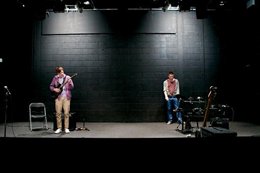Are you nostalgic for the days when you stood around, bashfully staring at your shoes, while desperately wanting to say “I kind of like you” to the boy/girl you really, actually, if you admitted it, liked a lot? Seeing Jon Fosse’s Purple, in a translation by David Harrower, gives you the opportunity to go back in time, to be voyeurs in scenes of teen angst, but without having to experience the angst yourself. The play is set in a band rehearsal room – sorry that’s too glamorous a description, it’s set in a grim cellar where a dysfunctional band that’s “going nowhere” attempts a rehearsal. The show starts with several minutes of improv, as the audience takes their seats, and it’s clear from these pre-play interactions that the band isn’t exactly a picture of unity. The bassist (Shane Byrne) keeps having to impress upon the drummer (Moe Dunford) that it’s important to “play the same thing, every time”. But teenagers want to express themselves, so being the same doesn’t appeal much to the drummer. Especially since, as we later learn, he’s losing the affections of The Girl (Rebecca Guinnane) to the band’s guitarist, The Boy (Manus Halligan).
 Fosse’s script is spare, relying on gesture and silence to convey the awkwardness of the interaction between the Boy and the Girl. Guinnane and Halligan are convincing as the nervous couple, performing both the tension and embarrassment of teenagedom. There are repeated musical riffs and repetitious dialogue, but no one is willing to risk exposing themselves, so they keep their sentences short, words minimal, resulting in an impoverished language that fails to convey much meaning. The gestures and silences, the muttered admissions at times ring true, as when the Girl encouragingly but increasingly desperately repeats “It’s good” each time the Boy plays a mournful self-written song for his grandmother. But at others, as when the Boy accuses her of being “a slut just like my mum”, it’s less effective, and one can’t help but long for the inarticulacy of characters in a Pinter play.
Fosse’s script is spare, relying on gesture and silence to convey the awkwardness of the interaction between the Boy and the Girl. Guinnane and Halligan are convincing as the nervous couple, performing both the tension and embarrassment of teenagedom. There are repeated musical riffs and repetitious dialogue, but no one is willing to risk exposing themselves, so they keep their sentences short, words minimal, resulting in an impoverished language that fails to convey much meaning. The gestures and silences, the muttered admissions at times ring true, as when the Girl encouragingly but increasingly desperately repeats “It’s good” each time the Boy plays a mournful self-written song for his grandmother. But at others, as when the Boy accuses her of being “a slut just like my mum”, it’s less effective, and one can’t help but long for the inarticulacy of characters in a Pinter play.
This is not a happy portrait; the friendships are flimsy and bullying is rife. The rivalry is ostensibly over the Girl, but is equally about proving oneself. The Drummer aggressively confronts the situation, bullying and then attacking the Boy, who passively accepts these attacks. But bullying is cyclical and we later see the Boy take out his own anger on the Girl. Watching this drama play out, however, was underwhelming, and perhaps  Edwina Casey’s direction could have upped the ante here, by making both confrontations edgier and riskier. These altercations were downplayed in terms of danger and in doing so, the tension was lost. Like the script, there’s not enough substance, so the stakes don’t feel that high. Ultimately, what the show struggles to convey, amidst all the teen angst and embarrassment, is the sometimes desperate loneliness, fear and chaos of being young and emotionally vulnerable. There are moments of empathy, but these aren’t enough to give the play emotional grit.
Edwina Casey’s direction could have upped the ante here, by making both confrontations edgier and riskier. These altercations were downplayed in terms of danger and in doing so, the tension was lost. Like the script, there’s not enough substance, so the stakes don’t feel that high. Ultimately, what the show struggles to convey, amidst all the teen angst and embarrassment, is the sometimes desperate loneliness, fear and chaos of being young and emotionally vulnerable. There are moments of empathy, but these aren’t enough to give the play emotional grit.
Even with the pauses and music, Purple is extremely short and feels like a series of glimpses rather than a fully formed one-act play. Though the performances are believable, the actors struggle without the support of depth of character and dialogue. The set is minimal, with black screens along the top and bottom creating a frame within which to view the action, almost as if we are looking at a widescreen film. There’s no other built set so the frame does a lot of work to delineate the space of action – and it’s not surprising that the designers, TAKA, are architects. The music is, as you’d expect, mediocre, for as the Boy frequently states “we’re not any good”. The guitar strains and manic drumming can at times be poignant, showing a group of young men in the process of becoming, but it is overall, a bit like the play itself, underformed.
Emile Pine